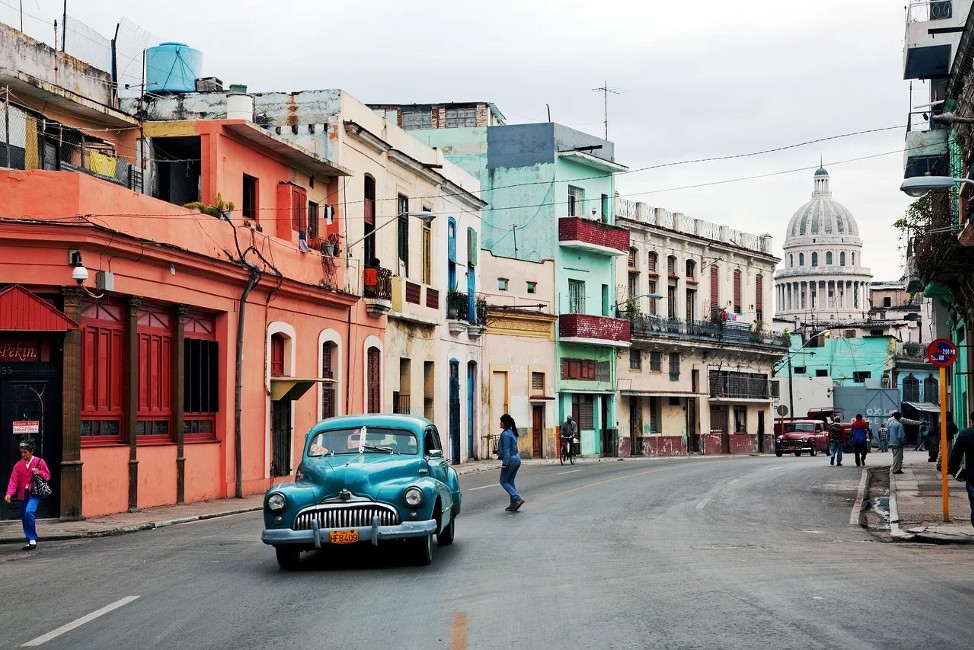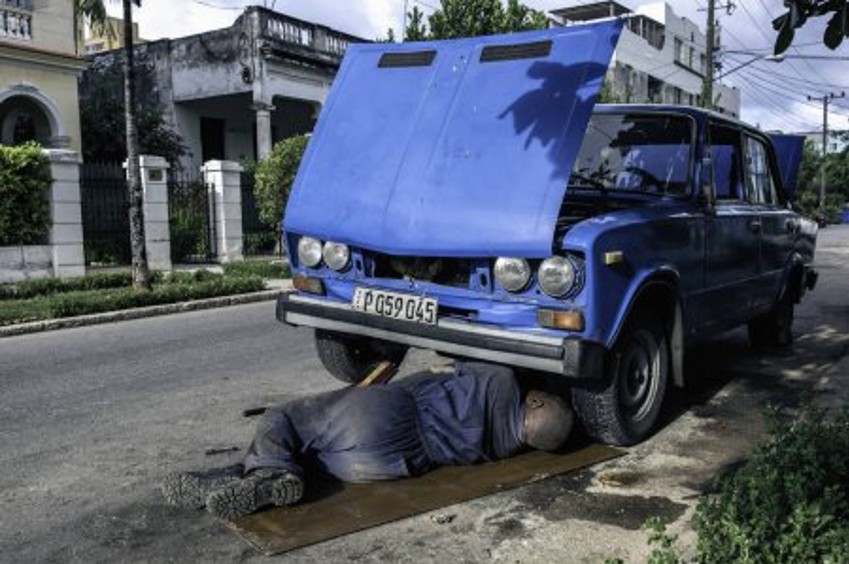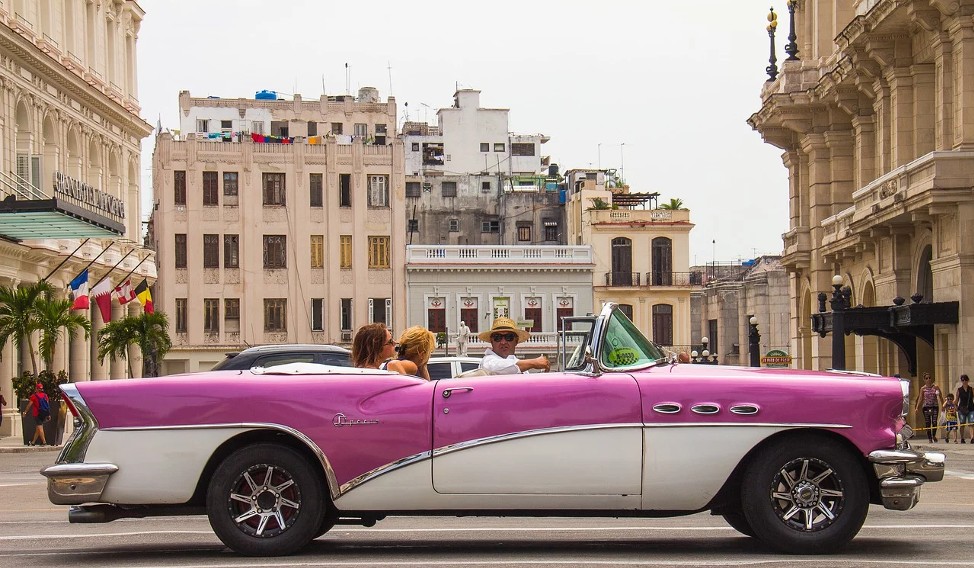Why Does Cuba Have Old Cars? This is a question that piques the curiosity of many, and at WHY.EDU.VN, we delve into the fascinating story behind this iconic aspect of Cuban culture. Explore the historical, political, and economic factors that have preserved these vintage vehicles, contributing to Cuba’s unique charm and resilience. Discover the ingenuity of Cuban mechanics and the enduring appeal of classic cars, along with the cultural significance of vintage vehicles.
1. The Allure of Classic Cars in Cuba: An Introduction
Cuba, a nation frozen in time, captivates visitors with its vibrant culture, rich history, and unique automotive landscape. The streets of Havana and other Cuban cities are a living museum, showcasing a stunning array of vintage American cars from the 1940s and 1950s. These meticulously maintained vehicles, often painted in eye-catching colors, are more than just modes of transportation; they are symbols of Cuban ingenuity, resilience, and cultural identity.
But why does Cuba have so many old cars? This question has fascinated travelers, historians, and car enthusiasts for decades. The answer lies in a complex interplay of historical events, political decisions, and economic realities that have shaped Cuba’s automotive landscape. This article will explore the reasons behind the prevalence of vintage cars in Cuba, tracing their history from the pre-revolutionary era to the present day.
2. Pre-Revolutionary Cuba: A Hub for American Automobiles
Before the 1959 Cuban Revolution, Cuba enjoyed close ties with the United States, which had a profound impact on the island’s automotive industry. During the first half of the 20th century, Cuba became a major importer of American cars.
2.1. Thriving Automotive Trade with the U.S.
Cuba’s relationship with the United States in the early to mid-20th century fostered a thriving automotive trade. American manufacturers like Ford, Chevrolet, Cadillac, and Chrysler saw Cuba as a lucrative market for their vehicles. As a result, Cuba was flooded with American cars, becoming one of the countries with the highest number of vehicles per capita in Latin America.
2.2. Cuba as a Testing Ground for American Automakers
Interestingly, Cuba also served as a testing ground for American automakers. Companies would often ship their latest models to Cuba to test their performance in the tropical climate and challenging road conditions. This meant that Cubans sometimes had access to new car models before they were even available in the United States.
2.3. The Ubiquitous Ford Model T
The Ford Model T, affectionately known as “fotingo” (meaning a clunker or jalopy), was a common sight on Cuban roads. Its affordability and reliability made it a popular choice among Cuban drivers. Even today, the term “fotingo” is used to describe any Cuban car that appears old or rundown.
3. The Cuban Revolution and the U.S. Embargo: A Turning Point
The 1959 Cuban Revolution marked a dramatic turning point in Cuba’s history, including its automotive industry. The revolution led to a deterioration of relations with the United States, culminating in a comprehensive trade embargo imposed by the U.S. in 1962.
3.1. The Imposition of the U.S. Embargo
The U.S. embargo had a devastating impact on Cuba’s ability to import new cars and spare parts from the United States. With the embargo in place, Cubans were effectively cut off from their primary source of vehicles and automotive supplies.
3.2. No New Cars or Spare Parts
The embargo meant that no new American cars could be imported into Cuba, and existing car owners could no longer obtain spare parts from the United States. This created a significant challenge for Cubans who relied on their cars for transportation.
3.3. The Necessity of Preservation and Innovation
Faced with a shortage of new cars and spare parts, Cubans were forced to find creative ways to keep their existing vehicles running. This necessity led to a culture of preservation, repair, and innovation that has become a hallmark of the Cuban automotive landscape.
4. The Era of “Invention”: Cuban Ingenuity and Resourcefulness
With limited access to new cars and spare parts, Cuban mechanics and car owners displayed remarkable ingenuity and resourcefulness in maintaining and repairing their vintage vehicles.
4.1. Becoming Mechanics Out of Necessity
Many Cubans were forced to become mechanics out of necessity, learning how to diagnose problems, fabricate parts, and adapt components from other vehicles to keep their cars on the road.
4.2. The Use of “Invention” to Keep Cars Running
Cuban mechanics became masters of “invention,” a term used to describe the creative solutions and improvisations used to repair and maintain cars. This often involved using whatever materials were available, from scrap metal and old appliances to parts from Soviet-era vehicles.
4.3. Adapting Parts from Soviet and Other Vehicles
With the U.S. embargo in place, Cuba turned to the Soviet Union and other communist countries for economic and technical assistance. This led to an influx of Soviet-made cars, such as Ladas, Volgas, and Moskviches. Cuban mechanics cleverly adapted parts from these vehicles to repair and maintain their American cars.
4.4. The Rise of Hybrid Cars: A Unique Cuban Phenomenon
The combination of American car bodies and Soviet-era engines and parts gave rise to a unique phenomenon in Cuba: the “hybrid car.” These vehicles, which retain the classic look of American cars but feature a mix of components from different manufacturers, are a testament to Cuban ingenuity and resourcefulness.
5. The Economic Realities: Why New Cars Remain Scarce
Even after the relaxation of some restrictions on car ownership in recent years, new cars remain scarce and prohibitively expensive for most Cubans due to a combination of factors.
5.1. High Import Taxes and Government Regulations
The Cuban government imposes high import taxes on new cars, making them unaffordable for the average Cuban citizen. Additionally, the government maintains strict regulations on car sales, limiting the availability of new vehicles.
5.2. State Monopoly on Car Sales
The state maintains a monopoly on car sales in Cuba, which allows it to control prices and limit competition. This lack of competition contributes to the high cost of new cars.
5.3. Average Cuban Income vs. Car Prices
The average Cuban income is relatively low, making it difficult for most people to afford a new car, even if they were readily available. A Peugeot 508, which typically retails for around $29,000, can cost upwards of $262,000 in Cuba due to import taxes and government markups.
6. The Cultural Significance of Old Cars in Cuba
The vintage cars of Cuba are more than just relics of the past; they are an integral part of Cuban culture and identity.
6.1. Symbols of Cuban Identity and Resilience
The old cars of Cuba have become symbols of Cuban identity, resilience, and resourcefulness. They represent the ability of Cubans to overcome adversity and maintain their cultural heritage in the face of economic and political challenges.
6.2. A Living Museum on Wheels
The streets of Cuba are like a living museum on wheels, showcasing a remarkable collection of vintage American cars. These vehicles provide a glimpse into Cuba’s past and offer a unique cultural experience for visitors.
6.3. Tourist Attraction and Source of Income
The vintage cars of Cuba have become a major tourist attraction, drawing visitors from around the world who come to admire and experience these classic vehicles. Many Cubans earn a living by offering tours in their vintage cars, providing a valuable source of income.
6.4. The Enduring Appeal of Classic American Design
The classic American car designs of the 1940s and 1950s continue to captivate people around the world. The vintage cars of Cuba are a testament to the enduring appeal of these iconic designs.
7. Taking a Ride in a Cuban Classic Car: An Unforgettable Experience
No trip to Cuba is complete without taking a ride in one of the many vividly colored vintage cars that line the streets of Havana and other Cuban cities.
7.1. Classic Car Tours in Havana and Other Cities
Classic car tours are a popular activity for tourists in Cuba. These tours offer a unique way to explore the cities and experience the country’s rich history and culture.
7.2. Experiencing Authentic Cuban Culture
Riding in a vintage car allows you to experience a slice of authentic Cuban culture. The drivers often share stories about the history of their cars and the challenges of keeping them running, providing insights into Cuban life.
7.3. Exploring the Countryside in Style
You can also rent a classic car for transport around the island. This allows you to explore the countryside in style, visiting tobacco-growing regions and other scenic destinations.
7.4. Supporting the Local Economy
By taking a classic car tour or renting a vintage car, you are supporting the local economy and helping Cuban car owners maintain their vehicles.
8. The Future of Old Cars in Cuba: Preservation vs. Modernization
The future of old cars in Cuba is uncertain, as the country faces the challenge of balancing preservation with modernization.
8.1. The Debate Over Importing New Cars
There is ongoing debate in Cuba over whether to allow the unrestricted import of new cars. Some argue that this would modernize the country’s transportation system and provide Cubans with more reliable vehicles. Others worry that it would erode Cuba’s unique automotive landscape and diminish its cultural identity.
8.2. The Challenges of Maintaining Vintage Vehicles
Maintaining vintage vehicles in Cuba is becoming increasingly challenging as spare parts become scarcer and more expensive. The lack of specialized tools and equipment also poses a significant obstacle.
8.3. Efforts to Preserve Cuba’s Automotive Heritage
Despite the challenges, there are ongoing efforts to preserve Cuba’s automotive heritage. Some organizations are working to provide Cuban mechanics with the tools, training, and resources they need to keep their vintage cars running.
8.4. The Role of Tourism in Preservation
Tourism plays a crucial role in the preservation of Cuba’s vintage cars. The demand for classic car tours and rentals provides a financial incentive for car owners to maintain their vehicles, ensuring that they remain a part of Cuba’s cultural landscape for years to come.
9. Addressing Common Misconceptions About Cuban Cars
Several misconceptions surround the old cars of Cuba. Let’s debunk a few:
| Misconception | Reality |
|---|---|
| All Cuban cars are original and untouched. | Most Cuban cars have been modified and repaired extensively over the years, with parts often sourced from different vehicles. |
| Cuban mechanics are not skilled. | Cuban mechanics are highly skilled and resourceful, having developed innovative techniques to keep their vintage cars running despite limited resources. |
| The U.S. embargo is the only reason for old cars in Cuba. | While the embargo played a significant role, economic factors, government regulations, and the cultural significance of vintage cars have also contributed to their prevalence. |
| Cuban cars are unsafe and unreliable. | While some Cuban cars may have safety issues due to their age and modifications, many are well-maintained and reliable thanks to the dedication of their owners and mechanics. |
| Only tourists ride in Cuban cars. | While tourists are a significant source of income for Cuban car owners, many Cubans also rely on vintage cars for transportation. |



10. FAQ: Unveiling More About Cuba’s Automotive Treasures
Q1: Why are there so many old American cars in Cuba?
A: The U.S. embargo, imposed in 1962, prevented Cuba from importing new cars and spare parts from the United States, leading to the preservation of pre-revolutionary American vehicles.
Q2: Are Cuban cars all original?
A: No, most Cuban cars have been modified and repaired extensively over the years, often with parts sourced from different vehicles.
Q3: How do Cuban mechanics keep the old cars running?
A: Cuban mechanics are highly skilled and resourceful, using their ingenuity to fabricate parts and adapt components from other vehicles.
Q4: Is it safe to ride in a Cuban car?
A: While some Cuban cars may have safety issues due to their age, many are well-maintained and reliable.
Q5: Can I rent a classic car in Cuba?
A: Yes, you can rent a classic car with a driver for tours or transportation around the island.
Q6: Are new cars available in Cuba?
A: Yes, new cars are available, but they are scarce and prohibitively expensive for most Cubans.
Q7: What is the cultural significance of old cars in Cuba?
A: The old cars of Cuba have become symbols of Cuban identity, resilience, and resourcefulness.
Q8: What is a “fotingo”?
A: “Fotingo” is a Cuban term for a clunker or jalopy, often used to describe an old or rundown car.
Q9: How can I support the preservation of Cuban cars?
A: You can support the preservation of Cuban cars by taking a classic car tour, renting a vintage car, or donating to organizations that support Cuban mechanics.
Q10: Will the old cars of Cuba disappear in the future?
A: The future of old cars in Cuba is uncertain, but ongoing efforts to preserve them suggest that they will remain a part of Cuba’s cultural landscape for years to come.
11. Conclusion: The Enduring Legacy of Old Cars in Cuba
The vintage cars of Cuba are a testament to the ingenuity, resilience, and cultural identity of the Cuban people. They represent a unique blend of history, politics, and economics that has shaped the island’s automotive landscape. Whether you are a car enthusiast, a history buff, or simply curious about Cuban culture, a visit to Cuba and a ride in one of its classic cars is an unforgettable experience.
At WHY.EDU.VN, we understand the importance of providing accurate and insightful information about the world around us. We hope this article has shed light on the question of why Cuba has so many old cars and has inspired you to learn more about this fascinating aspect of Cuban culture.
Are you curious about other unique cultural phenomena or historical events? Do you have questions that need answering? Visit WHY.EDU.VN today and let our team of experts provide you with the knowledge and insights you seek. Contact us at 101 Curiosity Lane, Answer Town, CA 90210, United States, or reach out via Whatsapp at +1 (213) 555-0101. We are here to answer your questions and fuel your curiosity. Let why.edu.vn be your guide to understanding the world.
